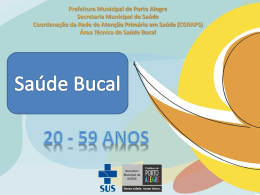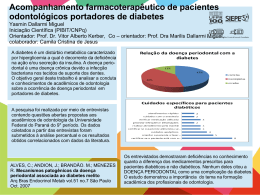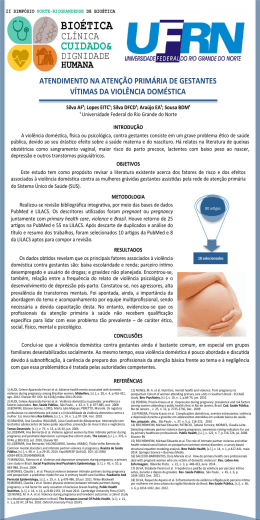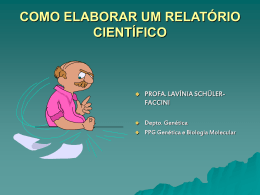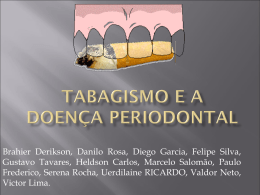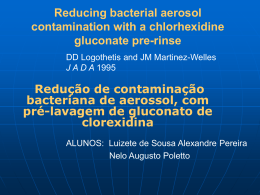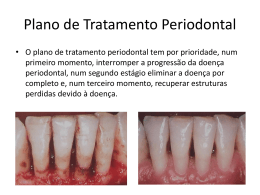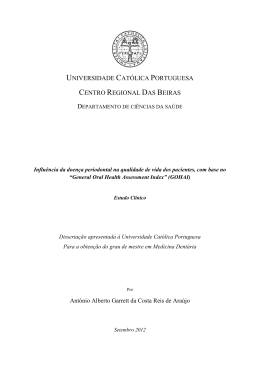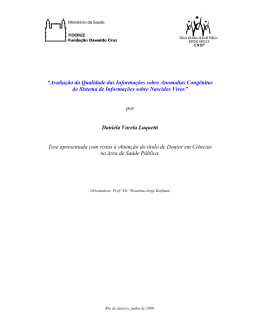Saúde Oral durante a Gravidez (Oral Health During Pregnancy) Silk H. et al Am Fam Physician 2008;77:1139-1144 Internato em Ginecologia Obstetrícia/HRAS/SES/DF Orientadora: Dra. Denise Cidade Luisa Ciucci Ferreira Marcela de Almeida Wanderley Murilo O. de Almeida Paulo Henrique G.Pereira www.paulomargotto.com.br Introdução • Saúde bucal na gestação: freqüentemente ignorada pelos profissionais da saúde (Somente 22 a 34% das gestantes nos EUA consultam o dentista durante a gravidez;das que têm problemas, somente 50%) • Ausência de guidelines para manejo da saúde bucal na gestação – insegurança por parte dos profissionais de saúde, acesso não é universal Os médicos devem diagnosticar e tratar ou encaminhar as gestantes, garantindo a saúde bucal Patologias orais na gestação • Lesões orais • Erosão do esmalte • Dieta, antiácidos e/ou antieméticos, enxaguatórios bucais com flúor • Cáries • Risco aumentado na gestação • Aumentam a probabilidade de surgimento de cáries na criança • Creme dental com flúor, dieta e tratamento dentário específico Cárie grave no adulto Patologias orais na gestação • Tumorações orais • Etiologia:Progesterona, bactérias e irritantes locais • Gengivais, crescimento rápido, involuem após o parto • Amolecimento dentário • Ação da progesterona e estrógenos • Não ocorrem perdas Tumoração oral na gestação (granuloma piogênico) Patologias orais na gestação • Gengivite • Patologia mais prevalente, piora na gestação • Tratamento: Escovação cuidadosa, enxaguatório bucal com clorexidina Gengivite Patologias orais na gestação Periodontite • • • • • • (Inflamação destrutiva do periodonto (afeta aproximadamente 30% da mulheres na idade de procriar) Infiltração bacteriana do periodonto Toxinas bacterianas estimulam a resposta inflamatória crônica, com destruição do periodonto e formação de bolsas que tornam-se eventualmente infectadas Pode induzir bacteremia recorrente, iniciando a produção de citocinas, prostaglandinas (PGE2) e interleucinas (IL-6, IL-8) que podem afetar a gestação Parece provável que a cascata inflamatória pode iniciar o trabalho de parto prematuro a causa de RN de baixo peso: a PGE2 restringe o fluxo placentário, causando necrose placentária e restrição do crescimento intra-uterino Periodontite • Diagnóstico precoce e raspagem da raiz , educação da paciente, remoção regular de placas e uso enxaguatório bucal com clorexidina , reduziu significativamente a incidência de nascimento de RN de baixo peso prematuro: RR= 0,18 ;IC de 0,05 0,6 (Lópes NJ et al, 2005) Periodontite moderada gravidade Periodontite x Prognóstico -Relação positiva entre periodontite e desfecho clínico ruim (pré-termo, baixo peso ou ambos) para o RN (Clothier B et al,2007) •De 31 estudos publicados, 22 evidenciaram relação entre periodontite e desfecho ruim -Estudo recente controlado e randomizado de Michalowicz et al não detectou benefício do tratamento, não sendo relatado malefícios a mãe ou ao feto Periodontite x Prognóstico • Causas de resultados variáveis: raça negra (mais casos de periodontite relacionada ao nascimento prematuro); o tratamento da periodontite durante a gravidez pode ser tardio para evitar nascimento prematuro • Não há malefícios descritos com os tratamentos propostos • A Academia Americana de Periodontologia recomenda que toda gestante tenha avaliação da saúde bucal no início da gestação. Diagnóstico e Prevenção • Avaliar sempre: • • • • • Saúde bucal Acesso à água fluorada Hábitos de higiene Disponibilidade de consultas odontológicas Cavidade oral ( exame) • Orientar: • Escovação e uso de fio dental • Dieta • Agendamento de consulta precoce com Dentista Diagnóstico e prevenção • Xylitol e clorexidina podem reduzir carga bacteriana e transmissibilidade quando usados ao final da gestação ou no pós-parto (ambos categoria B) • Radiografias: Após o 1º trimestre, só quando realmente necessárias • Tratamento dentário: Recomenda-se que seja realizado no 2º trimestre, se urgente pode ser feito em qualquer período, no 3º trimestre deve-se atentar para a posição da gestante na cadeira. Não postergar o tratamento para o pós -parto!!! Tratamento dentário Drogas: • Lidocaína com ou sem vasoconstritor é adequada(respeitar doses indicadas) • Benzodiazepínicos devem ser evitados (categoria D) • Penicilina, Amoxacilina e Cefalexina podem ser usadas (categoria B) • Se paciente for alérgica usar clindamicina ou eritromicina (categoria B) • Dor: paracetamol (categoria B) ou Ibuprofeno (categoria D no 3º TM) Resumo das Recomendações Referências do artigo: • • • • • • • Allston AA. Improving women's health and perinatal outcomes: the impact of oral diseases. Baltimore, Md.: Women's and Children's Health Policy Center, 2002. http://www.jhsph.edu/wchpc/publications/. Accessed August 1, 2007.2. Gaffield ML, Gilbert BJ, Malvitz DM, Romaguera R. Oral health during pregnancy: an analysis of information collected by the pregnancy risk assessment monitoring system. J Am Dent Assoc. 2001;132(7):1009-1016.3. Kumar J, Samelson R, eds. Oral health care during pregnancy and early childhood: practice guidelines. New York, NY: New York State Department of Health, 2006. http://www.health.state.ny.us/publications/0824.pdf. Accessed August 1, 2007.4. Stefanac S. How systemic conditions can affect treatment planning: pregnant patients. In: Stefanac SJ, Nesbit SP, eds. Treatment Planning in Dentistry. St Louis, Mo.: Mosby; 2001:92-94.5. Wasylko L, Matsui D, Dykxhoorn SM, Rieder MJ, Weinberg S. A review of common dental treatments during pregnancy: implications for patients and dental personnel. J Can Dent Assoc. 1998;64(6):434-439.6. American Dental Association Council on Access, Prevention and Interprofessional Relations. Women's oral health issues. American Dental Association, 2006. http://www.ada.org/prof/resources/topics/healthcare_womens.pdf. Accessed August 1, 2007.7. Lewis CW, Milgrom P. Fluoride [published correction appears in Pediatr Rev. 2003;24(12):429]. Pediatr Rev. 2003;24(10):327-336. • • • • • • • • U.S. Depa. of Health and Human Services, National Institute of Dental and Craniofacial Research. Oral Health in America: A Report of the Surgeon General. NIH publication no. 00-4713. Rockville, Md.: U.S. Public Health Service, Dept. of Health and Human Services; 2000.9. Hey-Hadavi JH. Women's oral health issues: sex differences and clinical implications. Women's Health Prim Care. 2002;5(3):189-199.10. Berkowitz RJ. Acquisition and transmission of mutans streptococci. J Calif Dent Assoc. 2003;31(2):135-138.11. Sills ES, Zegarelli DJ, Hoschander MM, Strider WE. Clinical diagnosis and management of hormonally responsive oral pregnancy tumor (pyogenic granuloma). J Reprod Med. 1996;41(7):467-470.12. Scheutz F, Baelum V, Matee MI, Mwangosi I. Motherhood and dental disease. Community Dent Health. 2002;19(2):67-72.13. American Academy of Periodontology. Periodontal (gum) diseases. http://www.perio.org/consumer/2a.html. Accessed August 1, 2007.14. Boggess KA, Edelstein BL. Oral health in women during preconception and pregnancy: implications for birth outcomes and infant oral health. Matern Child Health J. 2006;10(5 suppl):S169-S174.15. Dörtbudak O, Eberhardt R, Ulm M, Persson GR. Periodontitis, a marker of risk in pregnancy for preterm birth. J Clin Periodontol. 2005;32(1):4552. • • • • • • • • • • • Goepfert AR, Jeffcoat MK, Andrews WW, et al. Periodontal disease and upper genital tract inflammation in early spontaneous preterm birth. Obstet Gynecol. 2004;104(4):777-783.17. Offenbacher S, Lieff S, Boggess KA, et al. Maternal periodontitis and prematurity. Part I: obstetric outcome of prematurity and growth restriction. Ann Periodontol. 2001;6(1):164-174.18. Help reduce cost: the economic costs. March of Dimes. http://www.marchofdimes.com/prematurity/21198_10734.asp. Accessed July 1, 2007.19. Clothier B, Stringer M, Jeffcoat MK. Periodontal disease and pregnancy outcomes: exposure, risk and intervention. Best Pract Res Clin Obstet Gynaecol. 2007;21(3):451-466.20. Michalowicz BS, Hodges JS, DiAngelis AJ, et al. Treatment of periodontal disease and the risk of preterm birth. N Engl J Med. 2006;355(18):1885-1894. 21. Jeffcoat MK, Hauth JC, Geurs NC, et al. Periodontal disease and preterm birth: results of a pilot intervention study. J Periodontol. 2003;74(8):1214-1218.22. López NJ, Da Silva I, Ipinza J, Gutiérrez J. Periodontal therapy reduces the rate of preterm low birth weight in women with pregnancy-associated gingivitis. J Periodontol. 2005;76(11 suppl):2144-2153.23. Task Force on Periodontal Treatment of Pregnant Women, American Academy of Periodontology. American Academy of Periodontology statement regarding periodontal management of the pregnant patient. J Periodontol. 2004;75(3):495.24. Livingston HM, Dellinger TM, Holder R. Considerations in the management of the pregnant patient. Spec Care Dentist. 1998;18(5):183-188.25. National Collaborative Perinatal Project. 1959-1974, Record Group 443, National Institutes of Health. http://www.motherisk.org. Accessed July 1, 2007.26. Söderling E, Isokangas P, Pienihäkkinen K, Tenovuo J, Alanen P. Influence of maternal xylitol consumption on mother-child transmission of mutans streptococci: 6-year follow-up. Caries Res. 2001;35(3):173-177. • Brambilla E, Felloni A, Gagliani M, Malerba A, García-Godoy F, Strohmenger L. Caries prevention during pregnancy: results of a 30-month study. J Am Dent Assoc. 1998;129(7):871-877.28. • American Dental Association, U.S. Dept. of Health and Human Services. The selection of patients for dental radiographic examinations. Revised 2004. http://www.ada.org/prof/resources/topics/topics_radiography_ex aminations.pdf. Accessed August 1, 2007.29. • ACOG Committee Opinion. Number 299, September 2004. Guidelines for diagnostic imaging during pregnancy. Obstet Gynecol. 2004;104(3):647-651.30. • Briggs GG, Freeman RK, Yaffe SJ. Drugs in Pregnancy and Lactation: A Reference Guide to Fetal and Neonatal Risk. 7th ed. Philadelphia, Pa.: Lippincott Williams & Wilkins; 2005.31. • Hilgers KK, Douglass J, Mathieu GP. Adolescent pregnancy: a review of dental treatment guidelines. Pediatr Dent. 2003;25(5):459-467. Sugestão de consultas, aqui e agora! • Avanços no diagnóstico e prevenção da sepse neonatal Autor(es): Richard Polin (EUA). Realizado por Paulo R. Margotto ......assim, não temos respostas se o tratamento da periodontite será de valor • Jeffcoat MK, Geurs NC, Reddy MS, Cliver SP, Goldenberg RL, Hauth JC. • Periodontal infection and preterm birth: results of a prospective study. • J Am Dent Assoc. 2001 Jul;132(7):875-80. • Michalowicz BS, Hodges JS, DiAngelis AJ, Lupo VR, Novak MJ, Ferguson JE, Buchanan W, Bofill J, Papapanou PN, Mitchell DA, Matseoane S, Tschida PA; OPT Study. • Treatment of periodontal disease and the risk of preterm birth. • N Engl J Med. 2006 Nov 2;355(18):1885-94. • López NJ, Smith PC, Gutierrez J. • Higher risk of preterm birth and low birth weight in women with periodontal disease. • J Dent Res. 2002 Jan;81(1):58-63 • Zadeh-Modarres S, Amooian B, BayatMovahed S, Mohamadi M. • Periodontal health in mothers of preterm and term infants. Taiwan J Obstet Gynecol. 2007 Jun;46(2):157-61 • Alves RT, Ribeiro RA. • Relationship between maternal periodontal disease and birth of preterm low weight babies. Braz Oral Res. 2006 Oct-Dec;20(4):31823 • Vettore MV, Lamarca Gde A, Leão AT, Thomaz FB, Sheiham A, Leal Mdo C. Periodontal infection and adverse pregnancy outcomes: a systematic review of epidemiological studies. Cad Saude Publica. 2006 Oct;22(10):2041-53. Review • Boggess KA, Edelstein BL. Oral health in women during preconception and pregnancy: implications for birth outcomes and infant oral health. Matern Child Health J. 2006 Sep;10(5 Suppl):S169-74. Review • Sadatmansouri S, Sedighpoor N, Aghaloo M. Effects of periodontal treatment phase I on birth term and birth weight. J Indian Soc Pedod Prev Dent. 2006 Mar;24(1):23-6. • Vettore MV, Sheiham A, Peres MA. Low birth weight and periodontal diseases association. Rev Saude Publica. 2006 Feb;40(1):1845, 181-2; author reply 185-6, 182-3. Epub 2006 Jan 4. English, Portuguese. No abstract available. • Cruz SS, Costa Mda C, Gomes Filho IS, Vianna MI, Santos CT. [Maternal periodontal disease as a factor associated with low birth weight] Rev Saude Publica. 2005 Oct;39(5):7827. Epub 2005 Oct 24. Portuguese • Yeo BK, Lim LP, Paquette DW, Williams RC. Periodontal disease -- the emergence of a risk for systemic conditions: pre-term low birth weight. Ann Acad Med Singapore. 2005 Jan;34(1):111-6. Review • Rajapakse PS, Nagarathne M, Chandrasekra KB, Dasanayake AP. Periodontal disease and prematurity among non-smoking Sri Lankan women. J Dent Res. 2005 Mar;84(3):274-7 • Mokeem SA, Molla GN, Al-Jewair TS. The prevalence and relationship between periodontal disease and pre-term low birth weight infants at King Khalid University Hospital in Riyadh, Saudi Arabia. J Contemp Dent Pract. 2004 May 15;5(2):40-56 • Louro PM, Fiori HH, Filho PL, Steibel J, Fiori RM. [Periodontal disease in pregnancy and low birth weight] J Pediatr (Rio J). 2001 Jan-Feb;77(1):238. Portuguese • Davenport ES, Williams CE, Sterne JA, Murad S, Sivapathasundram V, Curtis MA. Maternal periodontal disease and preterm low birthweight: case-control study. J Dent Res. 2002 May;81(5):313-8 • Krejci CB, Bissada NF. Women's health issues and their relationship to periodontitis. J Am Dent Assoc. 2002 Mar;133(3):323-9. Review Obrigado! Dda Marcela Ddo Paulo Henrique Dda Luisa
Download
